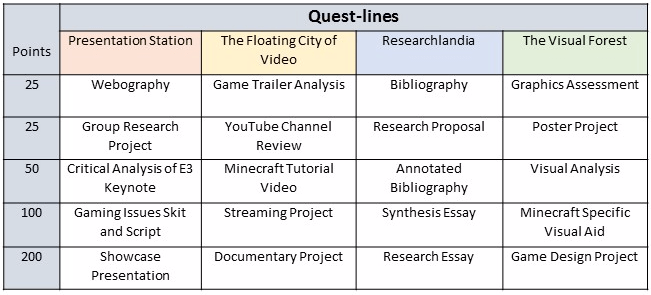
The chart above demonstrates the four quest-lines that were offered: Presentation Station, The Floating City of Video, Researchlandia, and The Visual Forest. Each questline was designed to appeal to a variety of learning styles and allow for creativity and flexibility. Students were required to complete two 25 point assignments, one 50 point assignment, one 100 point assignment, and one 200 point assignment at a minimum.
Note: Originally in my class, the points attached to each assignment were referred to as experience points or “xp” to mimic common game terminology.
For each quest-line, the assignments were designed to build into each other leading up to the final research-based project. The final research projects require students to take the skills and strategies used in earlier assignments and apply them to the final projects. While following a single guest-line to its completion seemed the most logical, students could pick and choose assignments that appealed to them. For example, a student might find the Presentation Station series of quests the most appealing, but she may not wish to work on the gaming issues skit and script. Instead, the student may opt to complete the Minecraft specific visual aid to fulfill the requirement of a 100 point assignment.
Before exploring the challenges and successes of this quest-line system, I would like to discuss each of the quest-lines separately to better demonstrate their appeal and the skills required of each.
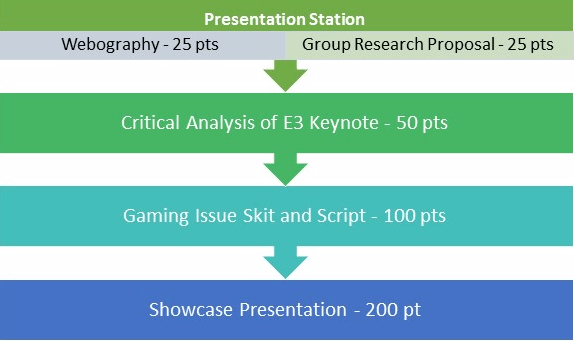
The Presentation Station is geared toward individuals who thrive with presentation work, oral rhetoric, and group activities. Students begin by researching game-related topics and writing a proposal on one topic of interest. The analysis of a keynote tests common elements of composition and rhetoric including topic, purpose, and audience. The game issue skit has students synthesize various sources regarding a controversial gaming issue into one cohesive skit where they must act out the voices from their sources. This assignment also serves as preparation for the final project. The showcase presentation allows students to demonstrate their research, writing skills, and ability to present on complex issues to the entire class. Students typically put together visual aids in the form of PowerPoints, trifold boards, and handouts to better engage the class and strengthen their rhetoric.
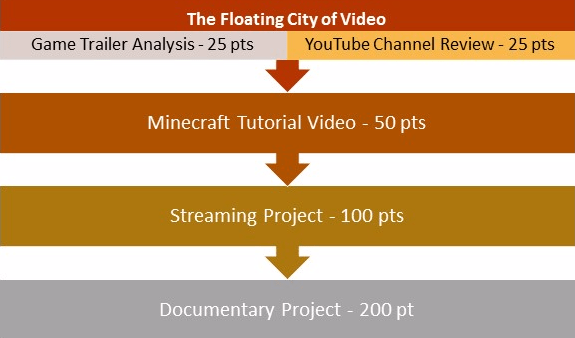
The first two assignments of this quest give students the opportunity to develop and hone their analysis of short videos and to reflect on the primary audiences and consequences of those texts. The Minecraft tutorial challenges students to compile a combination of visual and written texts to guide users to successfully accomplish something within the game of Minecraft such as how to build a castle or strip mine for diamonds. The streaming project works as a mini lesson in discourse analysis. Students select one channel from Twitch.tv and analyze the relationship between audience and game, audience and streamer, and streamer and game. For the documentary project, students pose 2-3 complex research questions to explore a significant issue. They then engage with the topic by conducting primary and secondary research before writing a report on their research methods and findings and filming a documentary.
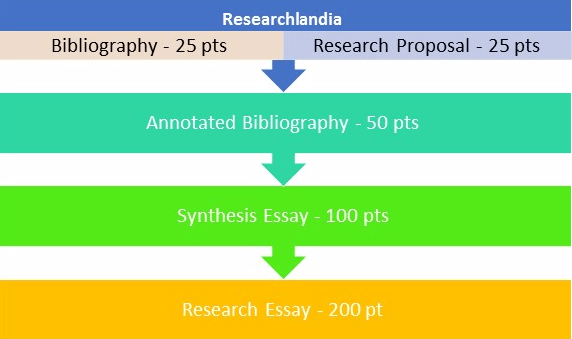
Researchlandia is the most familiar out of the four quests as it takes a fairly traditional approach to research in the composition classroom. Students begin by demonstrating their skill in compiling and assessing research before writing a proposal followed by an annotated bibliography. The synthesis essay is an exercise in summary, evaluation, and analysis of multiple texts leading nicely into the research essay. As with all the final quest options, the research essay allows students to pick a game-related topic of interest to them, explore the issue, synthesize various voices, and offer their own observations and even solutions to complex problems.
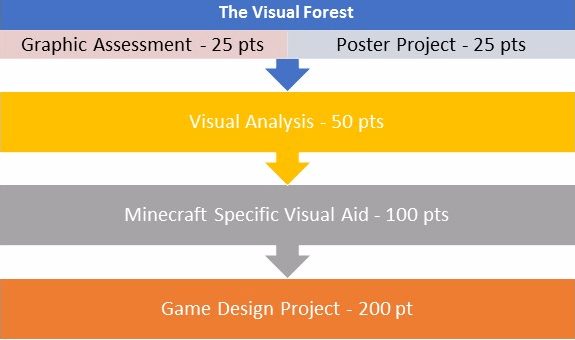
Similar to The Floating City of Video, The Visual Forest appeals to creative visual learners. The introductory assignments have students assess visual designs and then create their own advertisements of products or services in the form of posters. Students then tackle a more complex visual analysis where advertisements (commercials and/or other visuals) create, perpetuate, or challenge social norms and stereotypes relating to video games. The fourth assignment encourages students to create interactive visual aids within Minecraft and offers an opportunity for the creation of visual rhetoric within a game. The final project in this quest involves students designing their own game. Students must turn in a portfolio of work consisting of a game description, visual design documents, marketing material, and a multiple page proposal describing the game, the game’s purpose, and a basic budget and schedule for game development and completion.
Overall, I enjoyed teaching with a variety of interconnected assignments. Many of the assignments I received were creative and made my hours spent grading even more interesting than usual. The students also seemed to appreciate that they were given options even if they did not always make full use of them.
Roughly half of the students followed a single quest-line through its sequence of assignments and most of those students chose Researchlandia. It intrigues me that, given the options, quite a few students selected the more traditional assignments. For as much as students may request options, there is a sense of safety in the familiar.
The other half of the class picked assignments from across the quest-lines. Students seemed most appreciative of the options for final projects. Out of the four assignments, the traditional research essay and presentation were most popular. Again, better the devil you know as they say.
You might be asking yourself why educators would even consider using quest-lines. I decided to try them as an experiment for applying game design principles to the classroom. Games often give players choices which increases the players’ sense of agency. They are able to manipulate the outcome of the game in some way. Quests are a successful part of game design that often help players build toward something. Since quests often reward experience points, knowledge, or special equipment, they help players build stronger characters.
These game features work in video games, so why not try them in the classroom? When students complete assignments, they should be gaining knowledge, practicing their skills, and developing into even better students. This is something that should be happening naturally in every classroom whether instructors call their sequence of assignments “quest-lines” or not. And, as much as educators are meant to guide students, I am also a firm believer in taking command over your own education. This is frequently done when students have choices. They don’t have to take advantage of every option available to them, but the opportunity to decide for themselves is important especially when students are often herded through a queue of classes.
While I enjoyed experimenting with quest-lines for the sequencing of assignments, I am not sure that I would necessarily teach a full load of composition courses using this model. I would probably be far more efficient grading 96 of the same assignments, dull as that may be, than I would be grading a variety of four different assignments over a weekend. Small doses of variety might be best from the educator’s perspective, and perhaps that is why in nearly all of my writing courses as an undergraduate I was told what to write.
Instructors might also struggle with what to teach each class period with students potentially filtering themselves into four different quest-lines. I worked around this issue by teaching in my standard way the bulk of the semester addressing summary, evaluation, synthesis, analysis, and research skills. The last third of the class or so was run in a workshop fashion which encouraged students to help and instruct each other.
In the end, the quest-lines worked for both the students and myself with few complications, and it is something I wish to further experiment with in future semesters.
The system of quests used in my composition course was modelled off Justin Hodgson’s ideas as presented in “Developing and Extending Gaming Pedagogy: Designing a Course as Game.” Other iterations of quests exist, including Lee Sheldon’s ideas of solo, guild, and pick-up quests that mimic MMO (massively multiplayer online game) designs.
Feel free to share any thoughts or ideas you may have regarding quests and quest-lines in classrooms!

